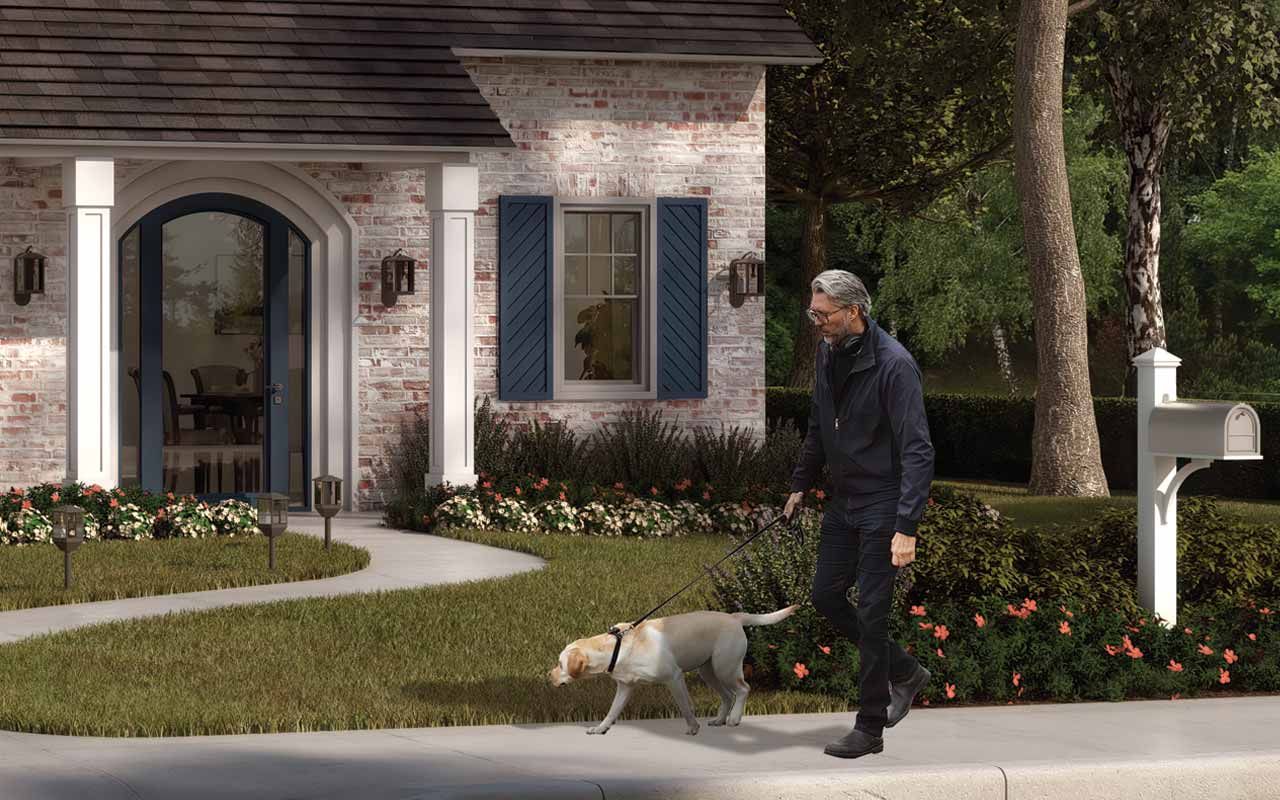
Your kids are successfully launched and, suddenly, you seem to have more disposable income. This could be a good time to tackle the remodeling projects you’ve been putting off. And while you’re updating your house for style, consider adapting it so you can age in place comfortably. There are smart ways to invest in updates that can enhance day-to-day living for yourself and future occupants.
Studies show that 75% of homeowners age 50 and older say they want to remain in their house as they age, but most U.S. homes weren’t built to accommodate older people’s special needs. A mere 10% of U.S. homes have key features to accommodate older residents, according to the Census report: Old Housing, New Needs: Are U.S. Homes Ready for an Aging Population?
For example, only 1 in 10 homes have a step-free entryway, a bedroom, and a full bathroom on the first floor. Residents in the Mid-Atlantic region have the biggest challenges, with only 6% homes being aging-ready. Whereas, 14% of homes are aging-ready in the West South Central area of the country, which includes Arkansas, Louisiana, Oklahoma and Texas.
Let's take a walk you through a house to identify features you could add, as well as identifying what they typically cost and how to pay for them.
One of the most popular projects is to install a curbless shower (with grab bars) 3, even if it means removing the home’s only bathtub. That has long been a no-no because it could reduce the house’s resale value. But Dan Bawden, owner of Legal Eagle Contractors in Houston and a certified aging-in-place specialist, said that’s becoming less of a concern for homeowners today. Expect to pay anywhere from $6,000 to 12,000, according to ThisOldHouse.com, with the average cost coming in at $8,000. Your needs will determine how many grab rails to install and where. The grab bars and handrails, including installation can cost from $100 to $350 per bar.
Other features
1 Layout. Remodel a bathroom to create a 5-foot turning radius to accommodate a wheelchair.
2 Sink vanity. Choose a cabinet with room to accommodate a chair or wheelchair ($1,200 - $2,500) and the sink and faucet will cost an additional $150 - $600, according to Homeguide.com.
4 Comfort-height toilet. Add a toilet with a seat that is higher off the floor than standard models ($360 to $1,400 installed). Traditional toilets are 15 inches high. Comfort height toilets (or “right height” toilets) have higher seats than traditional toilets, usually between 17 inches and 19 inches.
Bawden’s clients often worry that the finished product will look institutional. “But we can do gorgeous projects in which the modifications are invisible,” he says. For example, he likes products from invisiacollection.com, a maker of grab bars that don’t look like grab bars and may serve double-duty as toilet-paper holders, soap dishes or shelves.
Installing maintenance-free materials is also important, says Bawden. For example, quartz countertops in the kitchen and bathroom are super-hard, scratch and stain-resistant, and never need sealing, unlike natural stone. Quartz is also less expensive than it used to be. Luxury vinyl plank (LVP) flooring is beautiful, waterproof, durable, comfortable underfoot, and never needs refinishing.
Other features
1 User-friendly appliances. Select easy-access models: A side-by-side-door refrigerator ($899 to $11,929.00), a stove with controls near the front ($349 to $12,599.00), a raised dishwasher ($680 to $1,300) and a microwave at countertop level ($180 to $1,600).
2 Pull-down shelving units. Retrofit upper cabinets to avoid lifting heavy items, from $34.44 for a spice rack up to $581 per cabinet.
3 LED lighting. Add lighting overhead ($100 to 480 per recessed fixture, installed) and under cabinets for $7 to $50 per strip, installed. Depending on the type of lights you select and how complex the installation is, you can pay anywhere between $85 and $675.
4 Sink faucet. Install a lever-handled faucet model that's easier to grasp, or go with a touchless version ($350 to $600, installed).
5 Non-slip flooring. Install flooring to prevent falls ($3-$22 per square foot, installed).
6 Roll-out shelves. Reface fixed shelves to avoid bending ($25 to $100 apiece).
1 D-shaped pulls. Add cabinet handles that are easier to grasp than knobs (from $2.40 apiece).
2 Workspaces. Vary the height of workspaces, or create space to work while seated (custom cost).
3 Lever-style handsets. Replace all household doorknobs ($13.59 to $130 apiece).
1 Rocker-style wall switches. Replace toggle-style wall switches with easier-to-use rocker-style ones for between $50 and $150. The cost to relocate a switch usually runs from $240 to $300, according to Fixr.com.
2 Doorway. Replace a narrow interior doorway with one that's 36 inches wide ($500 to $2,000).
3 Washer and dryer. Switch from top-loading to front-loading models installed on pedestals to lessen back strain. Look for doors that swing to the side, not down ($2,000 to $2,800 apiece, or $2,000 for space-saving combination unit).
4 Non-slip flooring. Replace deep-pile carpet and a thick pad with low-pile carpet and a firm pad, or install non-slip flooring ($3 to $22 per square foot, installed).
5 Custom closet organizer. Outfit closets with multilevel shelving and hanging units that are accessible whether you're sitting or standing ($1,000 for a reach-in closet to $6,500 for a walk-in closet).
1 Covered entranceway or portico. A 5-foot-square “landing pad” gives a wheelchair room to maneuver (about $7,500 to $12,000 for a simple portico).
2 Bench. Place a bench near the front door to rest yourself or your packages ($75 to $1,800).
3 Front door. Install a door that’s 36 inches wide. Choose a door with narrow windows on each side ($2,000 to $6,500, installed) or add peepholes (one for standing, one for sitting) for security.
4 Lighting. Add lights to the front of your home and along the sidewalk for safe passage at night (about $140 to $230 per light and $170 to $300 per exterior light, installed).
5 Concrete ramp. Replace the sidewalk and steps leading to the front door (about $2,000 to above $10,000).
For estimated project costs, the annual Cost Vs. Value Report from Journal of Light Construction is a good resource. In 2024, the national average cost for a minor kitchen remodel is $27,492. It's $79,982 for a major remodel and $158,530 for an upscale project. The average cost for a bathroom remodel with a universal design is $40,750 for a midrange project that includes design features to fit any age; it’s $78,840 for an upscale remodel.
If you want to add a first-floor master bedroom, the national average cost is between $80,000 and $200,000 for a midrange job. Ground-floor extensions ($200–$400 per sq. ft.) are slightly cheaper than second-story additions ($250–$500 per sq. ft.)
However, if you want to widen a bathroom door (bathroom and closet doors are often narrower and less accessible than other doors), the average cost is $4,348, according to Homeadvisor.com. The cost to widen a doorway for wheelchair access is higher if it’s a load-bearing wall. Overall, costs can run up to $12,500, depending on the scope of the work; the type of door is also an important pricing factor.
If you’re adding on to your home or building a multistory house, you could prepare for an elevator by stacking 6-foot-square closets. That way, when you’re ready, the contractor can just remove the floor between the closets.
For more costly projects, you could take out a home-equity line of credit (HELOC), from which you could borrow money as you need it. Or, if you or your spouse is at least age 62 and you have considerable equity built up in your home, you could take out a reverse mortgage with an up-front lump-sum payout or a line of credit. With a reverse mortgage, you must use some of the proceeds to pay off any remaining mortgage balance, but you’ll never have to make another monthly mortgage or loan payment. The debt will be repaid after you leave the home permanently and the house is sold. For more information on reverse mortgages, visit the websites of the Consumer Financial Protection Bureau and search for “reverse mortgage”) and the National Reverse Mortgage Lenders Association.
For help designing and constructing larger projects, look for a Certified Aging-in-Place Specialist who has completed a program developed by the National Association of Home Builders with AARP (go to nahb.org and search for “CAPS Directory”). You can also find a CAPS-certified contractor through the National Association of Home Builders with AARP (go to National Association of the Remodeling Industry; click on “I’m a consumer” and find “universal design” under the Homeowner Resources tab) and the National Association of Home Builders with AARP (go to National Kitchen and Bath Association click on “find a professional” and “service” and specify “universal design”).







